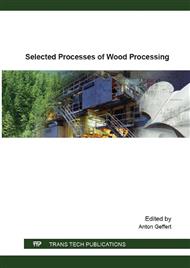[1]
A. Blažej, L. Košík, P. Krkoška, E. Golis., Chemistry of wood. Bratislava. ALFA, (1975). (in Slovak).
Google Scholar
[2]
V. Simanov, Energetic use of wood. Terrapolis, (1995). (in Czech ).
Google Scholar
[3]
A. Antonović, V. Jambreković, S. Pervan, J. Ištvanić, M. Moro, J. Zule, Influence of sampling location on sapwood group chemical composition of beech wood (Fagus sylvatica L. ). Drvna Industrija, 58: 3 (2007) pp.119-125. (in Croatian).
Google Scholar
[4]
J. Zule, J. Dolenc, Distribution of mineral substances in different wood tissues of european larch (Larix deciuda Mill. ). Drevna Industrija, 63: 1 (2012) pp.19-25. Doi: 10. 5552/drind. 2012. 1117.
DOI: 10.5552/drind.2012.1117
Google Scholar
[5]
L. Ditmarova, J. Kmet, M. Ježik, J. Valka, Mineral nutrition in relation to the Norway spruce forest decline in the region Horny Spiš (Northern Slovakia). Journal of Forest Science, 53: 3 (2007) pp.93-100.
DOI: 10.17221/2148-jfs
Google Scholar
[6]
P. Merilä, J. Derome, Relationships between needle nutrient composition in Scots pine and Norway spruce stands and the respective concentrations in the organic layer and in percolation water. Boreal Environment Research 13 (suppl. B), (2008).
Google Scholar
[7]
I. N. Nikitin, Wood chemistry. Prague. SNTL, (1956). (in Czech ).
Google Scholar
[8]
A. N. Buchanan, Extraneous Components in Wood. In: The Chemistry of Wood, New York – London – Sydney (1963).
Google Scholar
[9]
L. Dzurenda, Combustion of wood and bark. Zvolen, Technical University in Zvolen, (2005). (in Slovak).
DOI: 10.21272/mmi.2017.4-28
Google Scholar
[10]
K. M. Misra, K. W. Ragland, J. A. Baker, Wood ash composition as a function of furnace temperature. Biomass and Bioenergy, 4: 2 (1994) pp.103-116.
DOI: 10.1016/0961-9534(93)90032-y
Google Scholar
[11]
J. Malaťák, P. Vaculík, Biomass for energy. Prague: Editor CZU v Prague, (2008). (in Czech ).
Google Scholar
[12]
M. Zevenhoven, P. Yrjas, M. Hupe, Ash-forming matter and ash-related problems. Handbook of Combustion, 4: 14 (2010) pp.493-531.
DOI: 10.1002/9783527628148.hoc068
Google Scholar
[13]
L. Dzurenda, Ľ. Pňakovič, Quantification of the ash content from biofuel - wood according to ISO 1171 (2003) and EN 14775 (2010). Annals of Warsaw University of Life Sciences, No. 86 (2014).
Google Scholar
[14]
L. Dzurenda, Ľ. Pňakovič, Combustion characteristics of biofuels - fallen leaves of hardwood deciduous trees. Acta Facultatis Xylologiae Zvolen, 57: 1, (2015) pp.119-126. (in Slovak).
DOI: 10.15376/biores.10.3.5563-5572
Google Scholar
[15]
K. R. E. Fernandes, C. Marangoni, O. Souza, N. Sellin, Thermochemical characterization of banana leaves as a potencial energy source. Energy Conversion and Manamegent 75, (2013) pp.603-608.
DOI: 10.1016/j.enconman.2013.08.008
Google Scholar
[16]
STN 48 0058: 2004 Assortments of wood –Deciduous wood chips and sawdust. (in Slovak).
Google Scholar
[17]
STN 49 0108: 1993 Wood – Determination of density. (in Slovak).
Google Scholar
[18]
L. Varga, T. Godó, Fast-growing tree species and the possibility of increasing the production of biomass for energy. In Use of forest biomass for energy purposes in the Slovak Republic, Zvolen: LVU, (2002) pp.28-37. (in Slovak).
Google Scholar
[19]
A. Požgaj, a kol., Wood Structure and Properties. Bratislava: Nature, (1997). (in Slovak).
Google Scholar
[20]
S. I. Golovkov, F. I. Koperin, V. I. Najdenov, Energetičeskoe ispolzovanie drevesnych otchodov. Moskva. Lesnaja promyšlennosť, (1987). (in Russian).
Google Scholar
[21]
L. Varga, M. Bartko, The selection of poplars for energy crops. In: ntegrated logistics for the production and use, Technical University in Zvolen. (2010) pp.209-213. (in Slovak).
Google Scholar
[22]
L. M. Perelygin, Wood science. Bratislava: SVTL, (1965). (in Slovak).
Google Scholar
[23]
L. Regináč, Wood science II. VŠLD Zvolen, (1990). (in Slovak).
Google Scholar
[24]
M. K. Bhat, A. Ferm, M. Kärkkäinen, On the properties of one-year shoots of Betula pubescens Ehrh and Salixs pp. Silva Fennica, 15: 1 (1981) pp.18-22.
DOI: 10.14214/sf.a15038
Google Scholar
[25]
A. Banski, L. Dzurenda, Density and bulk density of green wood chips from dendromass of short rotation coppice grown on plantations. Acta Facultatis Xylologiae, Zvolen, 57: 2 (2014) pp.17-26. (in Slovak).
DOI: 10.7160/sab.2014.450106
Google Scholar
[26]
A. Matovič, Wood science. Czech University of Life Sciences Prague, (1977).
Google Scholar
[27]
L. Dzurenda, M. Zoliak, Chemical composition of the combustible in energy chips of wood species Populus - clones Max 5 grown on plantations. Acta Facultatis Xylologiae Zvolen, 53: 1 (2011) pp.87-92. (in Slovak).
Google Scholar
[28]
L. Dzurenda, L. Ridzik, M. Dzurenda, Granularity and bulk density chips from woody biomass energy plantation grown wood Salix viminalis clone Inger. Acta Facultatis Xylologiae Zvolen, 55: 1 (2012) pp.111-118. (in Slovak).
DOI: 10.7160/sab.2014.450106
Google Scholar
[29]
EN 14 961-1: 2010 Solid biofuels. Fuel specifications and classes.
Google Scholar


